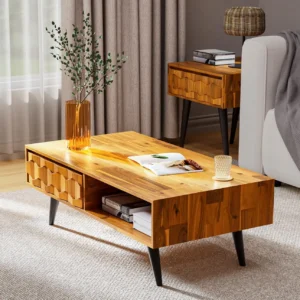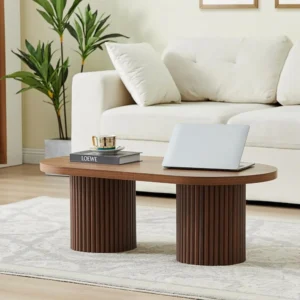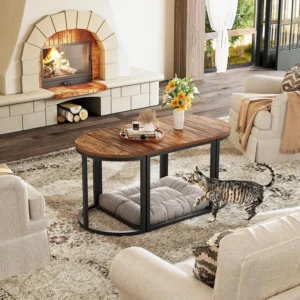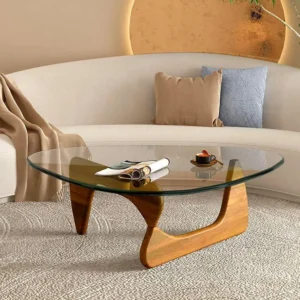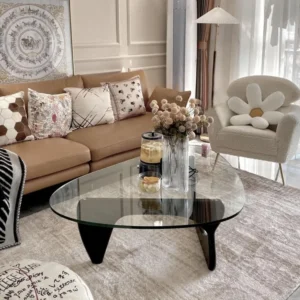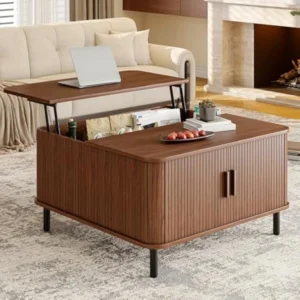The Unmatched Value of Solid Wood Coffee Tables
There’s something uniquely captivating about a solid wood coffee table that manufactured alternatives simply cannot replicate. Each piece tells a story through its grain patterns, natural color variations, and organic character that develops over time. When you choose solid wood for your living space’s centerpiece, you’re not just buying furniture—you’re investing in a piece of nature’s artistry.
Solid wood coffee tables offer several distinctive advantages:
• Authentic beauty that cannot be perfectly duplicated
• Exceptional durability that can last for generations when properly maintained
• Unique character with each piece having its own natural fingerprint
• Growing value as quality wooden furniture often appreciates over time
• Sustainability when sourced responsibly, connecting your home to nature
Many homeowners find that their mid-century modern solid wood coffee tables become treasured family heirlooms, passing from one generation to the next while developing a rich patina that tells the story of years of use and enjoyment.
In this comprehensive guide, we’ll explore the various types of wood commonly used for coffee tables, their distinctive characteristics, and how to select the perfect material for your specific needs, lifestyle, and aesthetic preferences. Whether you’re looking for unmatched durability, distinctive grain patterns, or a particular color tone, understanding these natural materials will help you make an informed decision you’ll enjoy for decades.
Understanding What “Solid Wood” Really Means
Before diving into specific wood types, it’s important to clarify exactly what “solid wood” means in the context of furniture. Many shoppers are surprised to discover that not all wooden coffee tables are created equal, and marketing terms can sometimes blur important distinctions.
Solid wood refers to pieces constructed from lumber cut directly from tree trunks and milled into boards or panels. Each component is made from genuine, natural wood throughout its entire thickness—there are no layers, fillers, or hidden materials. When you look at the edge or underside of a solid wood piece, you’ll see the same material all the way through.
This differs significantly from other “wood” furniture options you’ll encounter:
| Material Type | Construction | Appearance | Durability | Repair Potential |
|---|---|---|---|---|
| Solid Wood | 100% natural timber throughout | Authentic grain with natural variations | Excellent; can last generations | High; can be sanded and refinished multiple times |
| Veneer | Thin layer of real wood over engineered substrate | Real wood appearance on surface only | Moderate; depends heavily on substrate quality | Limited; can’t be deeply sanded |
| MDF/Particle Board | Processed wood fibers bonded with adhesives | Uniform, lacks natural grain | Fair to poor; susceptible to moisture damage | Poor; difficult to repair if damaged |
| Laminate | Printed image of wood on composite base | Artificial, repetitive patterns | Fair; scratch-resistant but unrepairable | Very poor; cannot be repaired when damaged |
These distinctions matter tremendously for several reasons. Solid wood furniture offers exceptional repairability—scratches and dents can be sanded out, and the piece can be refinished numerous times over its lifespan. This gives solid wood an inherent longevity that other materials simply cannot match.
Additionally, solid wood develops character over time through natural aging processes. Many species actually improve aesthetically as they mature, developing deeper, richer tones and a smooth patina from use. This living quality is something that enthusiasts of black mid-century coffee tables and other wooden furnishings particularly appreciate.
Hardwoods vs. Softwoods: Understanding the Two Main Categories
When exploring solid wood coffee table options, you’ll encounter two fundamental categories: hardwoods and softwoods. Despite what the names might suggest, these classifications don’t necessarily indicate the actual hardness of the wood, but rather refer to their botanical origins.
Hardwoods come from deciduous trees—those that lose their leaves annually. These include oak, walnut, maple, and cherry. Generally (though not always), hardwoods have:
• More complex grain patterns
• Higher density
• Greater strength
• Higher price points
• Slower growth cycles
Softwoods come from coniferous, evergreen trees like pine, cedar, and fir. These typically feature:
• Straighter, simpler grain patterns
• Lower density
• Less resistance to dents and scratches
• More affordable price points
• Faster growth cycles (greater sustainability)
However, it’s important to note that these are generalizations with many exceptions. For example, balsa is botanically a hardwood yet is extremely soft, while yew is technically a softwood but is quite hard and durable.
Here’s a quick comparison of how these categories typically perform in coffee tables:
| Characteristic | Hardwoods | Softwoods |
|---|---|---|
| Typical Durability | High to very high | Low to moderate |
| Price Range | Moderate to premium | Budget to moderate |
| Common Examples | Oak, Walnut, Maple, Cherry | Pine, Cedar, Fir |
| Best Use Cases | High-traffic areas, investment pieces | Budget options, rustic/casual styles |
| Sustainability | Slower growing (except for some species) | Generally faster growing |
When selecting between these categories, consider how they might work with your existing décor. Many styles that go well with mid-century modern furnishings tend to favor specific hardwoods like walnut or teak, though creative designers can work with either category effectively.
Oak: The Timeless Classic for Coffee Tables
Oak stands as perhaps the most traditional and widely recognized wood for quality furniture, and for good reason. This sturdy hardwood has been a furniture staple for centuries due to its remarkable combination of availability, workability, and longevity.
Origin and Variations:
• Red Oak: Slightly reddish undertones, more pronounced grain
• White Oak: More golden/brown tones, tighter grain pattern, superior moisture resistance
Appearance:
• Color ranges from light tan to medium brown
• Prominent, straight grain with distinctive growth ring patterns
• Quartersawn oak displays distinctive ray flake patterns prized in craftsman furniture
Performance Metrics:
• Janka Hardness: 1,220 for Red Oak, 1,360 for White Oak
• Excellent resistance to everyday wear
• Very good stability with minimal seasonal movement
Advantages:
• Exceptional durability for high-traffic homes
• Classic, timeless appeal that works in many design styles
• Good value compared to other hardwoods
• Readily available from sustainable sources
• Takes stains extremely well for color flexibility
Limitations:
• Can appear dated in some ultra-modern settings
• Heavier than some alternatives
• Susceptible to water staining (particularly Red Oak)
• Less distinctive than some premium hardwoods
Design Compatibility:
Oak coffee tables work beautifully in traditional, craftsman, farmhouse, and rustic interiors. For more contemporary spaces, white oak with modern design elements like black metal accents can create an updated look similar to what you’ll find in black mid-century coffee table design collections.
Walnut: Rich Elegance for Contemporary Coffee Tables
American Walnut (also called Black Walnut) represents the pinnacle of sophistication for many furniture enthusiasts and designers. Its rich chocolate brown color and natural elegance have made it the signature wood for mid-century modern design and premium contemporary furniture.
Origin and Characteristics:
• Native to Eastern North America
• Highly prized for furniture since colonial times
• Considered among the most beautiful domestic hardwoods
Appearance:
• Rich chocolate brown to purple-brown heartwood
• Occasional streaking with lighter sapwood (sometimes a design feature)
• Straight to slightly wavy grain with occasional figure
• Develops a lustrous patina with age and use
Performance:
• Janka Hardness: 1,010 (moderately hard)
• Excellent dimensional stability
• Good weight-to-strength ratio
• Moderate resistance to scratches and dents
Advantages:
• Sophisticated, luxurious appearance
• Ages beautifully, often becoming more attractive over time
• Natural oils provide some inherent moisture resistance
• Excellent for showcasing craftsmanship and joinery
• Perfect complement to mid-century aesthetics
Limitations:
• Premium price point (often 2-3× more than oak)
• Can fade somewhat with extensive direct sunlight
• Less scratch-resistant than maple or oak
• Limited availability of wide boards
Design Compatibility:
Walnut excels in mid-century modern, contemporary, and transitional interiors. Its rich tones create warmth without overwhelming a space. For inspiring examples, browse our collection of mid-century modern walnut coffee tables that showcase this wood’s natural beauty.
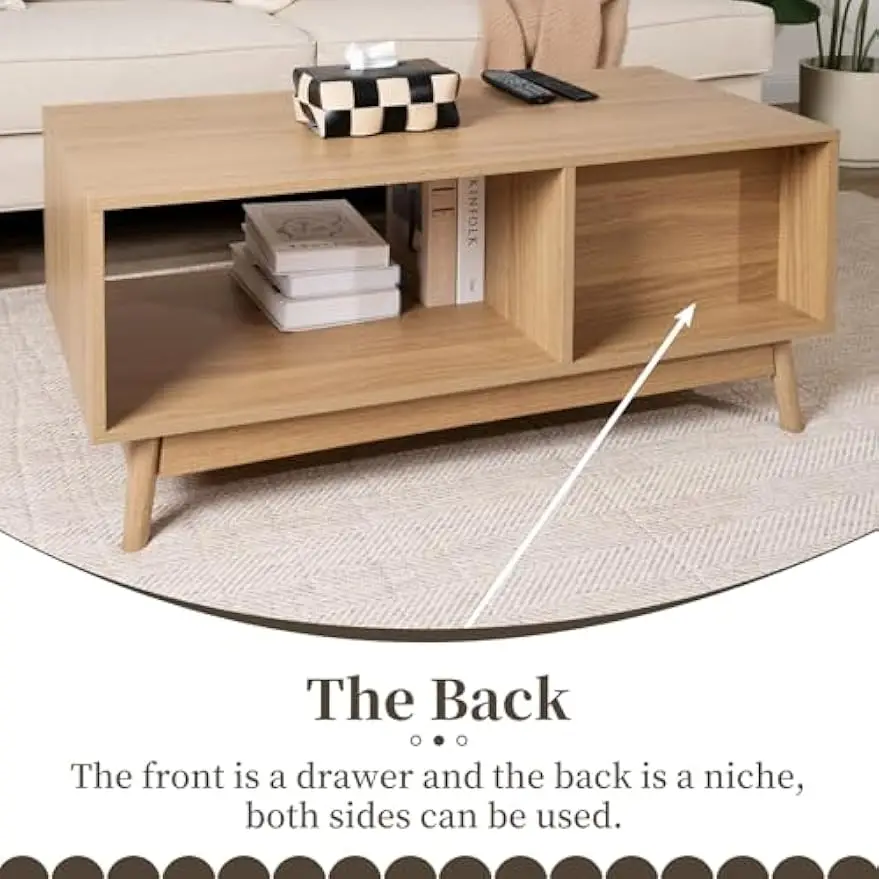
Maple: Bright Versatility with Superior Strength
Hard Maple (Sugar Maple) stands out as one of the strongest domestic hardwoods, offering exceptional durability in a clean, contemporary package. Its light color and subtle grain make it particularly versatile for both traditional and modern settings.
Origin and Variations:
• Hard Maple (Sugar Maple): Denser, harder, lighter in color
• Soft Maple (several species): Slightly softer, often with more character
• Both primarily harvested in northeastern North America
Appearance:
• Color ranges from nearly white to light reddish-brown
• Very subtle, fine grain pattern
• Occasional specialty figures like bird’s eye, curly, or tiger maple
• Uniform, clean appearance
Performance:
• Janka Hardness: 1,450 (exceptionally hard)
• Superior resistance to dents and impacts
• Good stability once properly dried
• Takes finish well, though can sometimes be blotchy with stains
Advantages:
• Exceptional durability for high-traffic areas
• Contemporary, clean aesthetic
• Bright appearance lightens spaces
• Takes paint extremely well when desired
• Sustainable North American harvesting
Limitations:
• Can appear somewhat plain without special figure
• May develop uneven patina over time
• Shows water spots more visibly than darker woods
• Limited natural color variation
Design Compatibility:
Maple coffee tables shine in Scandinavian, modern, minimalist, and contemporary settings. Its light tone makes it perfect for smaller spaces that benefit from brighter furnishings. Many designers pair maple with glass or metal accents for mid-century modern round coffee tables that make a subtle yet sophisticated statement.
Cherry: Developing Character and Warmth Over Time
American Cherry represents a fascinating choice for those who appreciate how wood evolves over time. Unlike most other woods, cherry undergoes a dramatic and beautiful transformation, deepening from a light pinkish-brown when freshly milled to a rich, warm reddish-brown with exposure to light.
Origin and Characteristics:
• Native to Eastern North America
• Historically prized for high-end traditional furniture
• Medium-density hardwood with smooth texture
Appearance:
• Initial color: Light pinkish-brown
• Aged color: Deep, warm reddish-brown
• Fine, straight grain with occasional subtle figuring
• Smooth, even texture that takes finish beautifully
Performance:
• Janka Hardness: 995 (moderately hard)
• Good stability once properly dried
• Excellent workability for detailed designs
• Moderate dent resistance
Advantages:
• Develops beautiful, rich patina over time
• Exceptionally smooth surface quality
• Takes finish better than almost any other wood
• Warm, inviting appearance
• Works in both traditional and contemporary settings
Limitations:
• Softer than many other hardwoods
• More susceptible to dents and scratches
• Significant darkening with age (a plus for some, a concern for others)
• Premium price point
Design Compatibility:
Cherry coffee tables excel in traditional, colonial, transitional, and some contemporary designs. Its warm tones create a welcoming contrast to cooler elements like glass or stone. For spaces that need warming up, cherry provides a beautiful alternative to the cooler tones found in many black coffee tables for mid-century interiors.
Teak: Premium Durability with Natural Weather Resistance
Teak stands apart from nearly all other furniture woods due to its remarkable natural oils and weather resistance. Originally used in shipbuilding, teak has become synonymous with premium, long-lasting furniture that requires minimal maintenance.
Origin and Sustainability:
• Native to Southeast Asia (primarily Myanmar, Thailand, Indonesia)
• Now also plantation-grown in Central and South America
• Slow-growing, making sustainability a concern
• Look for FSC-certified sources for responsible harvesting
Appearance:
• Golden-brown color that silvers naturally with age if untreated
• Straight grain with occasional irregular patterns
• Natural oil gives a slight sheen
• Moderate to coarse texture
Performance:
• Janka Hardness: 1,070 (moderately hard)
• Exceptional weather and moisture resistance
• Outstanding dimensional stability
• Excellent resistance to decay, insects, and fungi
Advantages:
• Natural oils prevent water damage
• Requires minimal maintenance
• Exceptionally long-lasting (can survive generations)
• Develops beautiful silver patina if left untreated
• Ideal for homes in humid climates
Limitations:
• Premium to luxury price point
• Sustainability concerns with some sources
• Can feel oily to the touch when new
• Limited availability of large pieces
Design Compatibility:
Teak coffee tables shine in mid-century modern, coastal, contemporary, and indoor-outdoor transitional spaces. The wood’s natural golden tone adds warmth to any room. Explore our mid-century modern teak coffee tables to see examples of this extraordinary material in timeless designs.
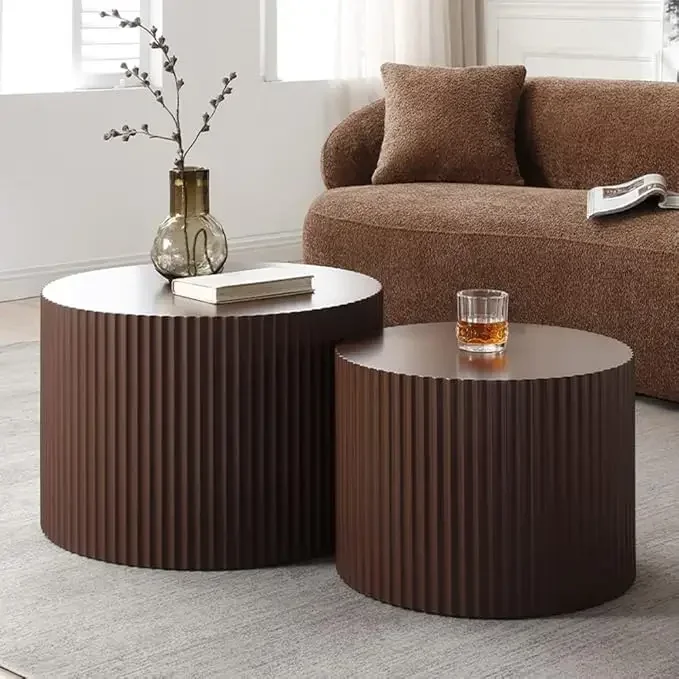
Pine: Affordable Charm with Rustic Character
As the most common and accessible softwood for furniture, pine offers a budget-friendly alternative with distinctive character. Its knots, light color, and casual appearance make it particularly suited to country and rustic styles.
Origin and Variations:
• Multiple species available (Eastern White Pine, Yellow Pine, etc.)
• Widely available from sustainable forests throughout North America and Europe
• Rapid growth makes it a renewable resource
Appearance:
• Pale yellowish to light brown color
• Prominent, distinctive knots and natural imperfections
• Straight grain with moderate natural luster
• Darkens slightly to a golden honey color with age
Performance:
• Janka Hardness: Varies by species (380-870, relatively soft)
• Moderate dimensional stability
• Very lightweight compared to hardwoods
• Softer surface prone to dents and scratches
Advantages:
• Significantly more affordable than hardwoods
• Rustic, casual charm with character
• Lightweight and easy to move
• Takes paint and stain extremely well
• Highly sustainable source material
Limitations:
• Easily dented and scratched in daily use
• Resin pockets can cause finishing issues
• More substantial movement with humidity changes
• Generally considered less prestigious than hardwoods
Design Compatibility:
Pine coffee tables excel in country, rustic, farmhouse, cottage, and casual living spaces. Its light, informal character creates a welcoming atmosphere. Pine’s versatility allows it to be finished in various ways, from natural to painted, providing alternatives to the sleeker aesthetic seen when decorating with black mid-century coffee tables.
Reclaimed Wood: Sustainable Character with Unique Stories
Reclaimed wood offers a compelling alternative that combines environmental benefits with unmatched character and history. Salvaged from old barns, factories, warehouses, and other structures, these repurposed timbers bring unique stories and distinctive aesthetics to contemporary furniture.
Sources and Definition:
• Salvaged from demolished buildings, barns, factories, ships, etc.
• Can include century-old old-growth timber no longer harvested
• May combine multiple species based on original structure
• Each piece has a unique history and provenance
Appearance:
• Weathered patina that cannot be authentically reproduced
• Distinctive character marks: nail holes, weathering, saw marks
• Color varies dramatically based on original use and species
• Often features denser growth rings than modern lumber
Performance:
• Typically very stable (already fully aged through decades of use)
• Hardness varies depending on original species
• Generally denser and stronger than newly harvested counterparts
• Natural aging process already complete
Advantages:
• Environmentally responsible choice (no new trees harvested)
• Unique character and history in each piece
• Often incorporates old-growth timber no longer available
• Conversation piece with authentic story
• One-of-a-kind appearance
Limitations:
• Higher cost than new softwoods (sometimes comparable to premium hardwoods)
• Limited selection and availability
• May have structural limitations based on original use
• Can have uneven surfaces or require more maintenance
Design Compatibility:
Reclaimed wood coffee tables excel in industrial, rustic, farmhouse, eclectic, and sustainable design contexts. They pair wonderfully with other natural materials like stone and metal. For unique character pieces, explore our mid-century modern vintage coffee tables that incorporate reclaimed elements.
Mahogany and Exotic Hardwoods: Premium Investment Pieces
For those seeking the pinnacle of luxury and distinction in wooden furniture, mahogany and other exotic hardwoods represent the ultimate investment. These premium materials have adorned the finest furniture for centuries, prized for their extraordinary beauty, workability, and longevity.
Origin and Varieties:
• True Mahogany: Caribbean and Central/South America (highly regulated, increasingly rare)
• African Mahogany: Similar appearance, more readily available
• Other premium exotics: Sapele, Jatoba, Rosewood, Ebony, Ipe
• Important to source from certified sustainable suppliers (FSC certification)
Appearance:
• Mahogany: Rich reddish-brown that deepens with age
• Straight to slightly interlocked grain
• Exceptional figure possibilities (ribbon, flame, crotch, etc.)
• Remarkable depth and chatoyance (light-reflecting quality)
• Distinctive appearance that’s instantly recognizable
Performance:
• Janka Hardness: Varies widely (Genuine Mahogany ~800, Jatoba ~2,350)
• Excellent stability with minimal movement
• Superb workability for detailed designs
• Exceptional longevity when properly maintained
Advantages:
• Unsurpassed beauty and prestige
• Historical significance in fine furniture
• Excellent working properties for detailed craftsmanship
• Remarkable longevity (many antique pieces are centuries old)
• Investment value that often appreciates
Limitations:
• Premium to luxury price point
• Sustainability and ethical sourcing concerns
• Limited availability of certain species
• More complex finishing requirements for optimal results
Other notable exotic options include:
• Sapele: Mahogany-like with more distinctive ribbon stripe
• Jatoba (Brazilian Cherry): Incredibly hard with deep red-brown color
• Ipe: Extremely dense with excellent weather resistance
• Zebrawood: Dramatic striped appearance for statement pieces
Design Compatibility:
Mahogany and exotic wood coffee tables excel in traditional, colonial, Federal, and high-end contemporary settings. Their natural elegance makes them ideal centerpieces in formal living spaces. For tips on showcasing these premium materials, see our guide on styling black mid-century coffee tables with complementary design elements.
Comparing Woods: Finding Your Perfect Match
With so many excellent wood options available, comparing their key characteristics side by side can help you identify which material best suits your specific needs and preferences. The following comparisons focus on the most important decision factors for coffee table selection.
Durability Comparison (Most to Least Durable)
| Wood Type | Janka Hardness | Dent Resistance | Scratch Resistance | Best For |
|---|---|---|---|---|
| Hard Maple | 1,450 | Excellent | Very Good | High-traffic family rooms |
| White Oak | 1,360 | Very Good | Very Good | Active households with children |
| Teak | 1,070 | Good | Good | Long-term investment pieces |
| Red Oak | 1,220 | Very Good | Good | Everyday family use |
| Walnut | 1,010 | Good | Moderate | Design-focused spaces with gentle use |
| Cherry | 995 | Moderate | Moderate | Adult households, formal spaces |
| Pine | 380-870 | Poor | Poor | Casual spaces, budget options |
Aesthetic Spectrum
| Wood Type | Color When New | Aged Color | Grain Prominence | Character Features |
|---|---|---|---|---|
| Maple | Pale cream to light tan | Subtle amber tones | Subtle, fine | Occasional bird’s eye or curl |
| Pine | Pale yellow | Golden honey | Moderate | Prominent knots, casual character |
| Oak | Light tan to medium brown | Minimal darkening | Prominent | Strong cathedral patterns |
| Cherry | Light pinkish-brown | Rich reddish-brown | Moderate | Smooth, subtle figuring |
| Walnut | Medium to dark brown | Deeper brown | Moderate | Occasional figure, color variation |
| Teak | Golden brown | Silver-gray (if untreated) | Moderate | Natural oil sheen, occasional dark streaks |
| Mahogany | Medium reddish-brown | Deep red-brown | Variable | Can include dramatic figure patterns |
Budget Considerations
| Price Tier | Wood Types | Approximate Price Range* |
|---|---|---|
| Entry-Level | Pine, Some Reclaimed | $300-$700 |
| Mid-Range | Oak, Ash, Some Maple | $700-$1,200 |
| Premium | Walnut, Cherry, Teak | $1,000-$2,500 |
| Luxury | Mahogany, Exotic Hardwoods | $1,500+ |
*Price ranges are approximate for quality solid wood coffee tables and can vary significantly based on design complexity, size, and craftsmanship.
Maintenance Requirements
| Wood Type | General Care Needs | Special Considerations |
|---|---|---|
| Teak | Low | Can be left untreated or oiled occasionally |
| White Oak | Low-Moderate | Good water resistance, simple cleaning |
| Walnut | Moderate | Some protection from direct sunlight |
| Red Oak | Moderate | Prompt attention to spills |
| Cherry | Moderate-High | UV protection to control darkening rate |
| Maple | Moderate-High | Shows water marks more visibly |
| Pine | High | Requires careful use, shows wear quickly |
These comparison charts provide a quick reference, but remember that each piece of wood is unique. The best black mid-century coffee tables often combine superior wood quality with exceptional craftsmanship, regardless of which species is selected.
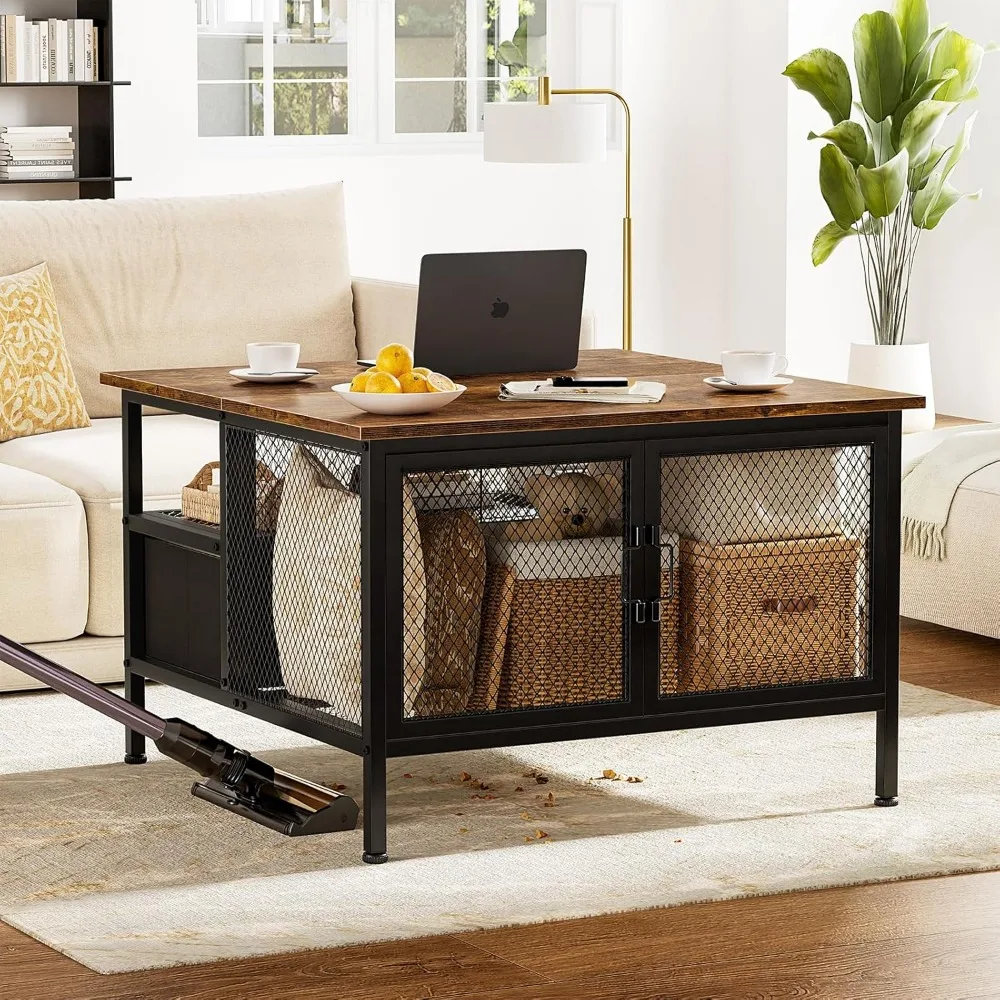
Selecting the Right Wood for Your Lifestyle
Beyond understanding the intrinsic properties of different woods, matching the right material to your specific lifestyle is crucial for long-term satisfaction with your coffee table. Consider these key lifestyle factors when making your selection:
Family Use Considerations
For households with young children:
• Hard maple and white oak offer superior resistance to the inevitable bumps and knocks
• Darker woods or those with prominent grain patterns better hide minor scratches
• Consider tables with rounded edges for safety
• Look for sturdy construction that can withstand climbing or leaning
For homes with pets:
• Harder woods resist claw marks better (maple, white oak)
• Medium-tone woods with some grain pattern help disguise light scratching
• Some woods like walnut can be more easily touched up when scratched
• Avoid softer woods like pine if you have active larger dogs
For adult-only households:
• More flexibility to choose based on aesthetics rather than extreme durability
• Better candidates for softer but beautiful woods like cherry
• Can consider premium woods where the patina of gentle use enhances character
Design Intent Questions
To match with existing furniture:
• Consider complementary rather than identical woods for interest
• Match undertones (warm or cool) rather than exact colors
• Consider the overall color palette of your room
• Think about contrast—light tables in darker rooms, darker tables in lighter spaces
For creating specific design statements:
• Modern/contemporary: Maple, walnut, teak
• Traditional/classic: Cherry, mahogany, oak
• Rustic/farmhouse: Pine, reclaimed wood, oak
• Eclectic: Mix of wood with other materials or reclaimed pieces
Maintenance Willingness
For low-maintenance preferences:
• Teak requires minimal care while still looking beautiful
• Darker woods with prominent grain hide small imperfections
• White oak offers good durability with relatively simple care
• Avoid woods that show water marks easily if you’re not diligent about coasters
For those willing to perform periodic care:
• Cherry rewards careful maintenance with increasingly beautiful patina
• Maple’s light color stays bright with regular care
• Regular conditioning keeps all woods looking their best
Our mid-century modern coffee tables collection includes options across the spectrum of wood types to match any lifestyle need, from highly durable family-friendly pieces to stunning showpieces for design enthusiasts. For additional insights on premium wood care, our article on iconic teak coffee table elements provides valuable guidance.
Mid-Century Modern Solid Wood Coffee Tables, Mid-Century Modern Teak Coffee Tables
$879.95 Select options This product has multiple variants. The options may be chosen on the product pageMid-Century Modern Danish Coffee Tables, Mid-Century Modern Oval Coffee Tables, Mid-Century Modern Solid Wood Coffee Tables
$390.05 Select options This product has multiple variants. The options may be chosen on the product pageMid-Century Modern Coffee & End Table Sets, Mid-Century Modern Coffee Table Sets, Mid-Century Modern Oval Coffee Tables
Price range: $257.48 through $331.04 Select options This product has multiple variants. The options may be chosen on the product pageMid-Century Modern Glass Top Coffee Tables, Mid-Century Modern Glass Top Side & End Tables
$460.58 Select options This product has multiple variants. The options may be chosen on the product pageMid-Century Modern Glass Top Coffee Tables, Mid-Century Modern Vintage Coffee Tables, Mid-Century Modern Vintage Side & End Tables
$725.36 Select options This product has multiple variants. The options may be chosen on the product pageMid-Century Modern Lift Top Coffee Tables, Mid-Century Modern Square Coffee Tables
$454.73 Select options This product has multiple variants. The options may be chosen on the product page
Ensuring Quality Beyond the Wood Type
While selecting the right wood species is crucial, the overall quality of a coffee table depends on many factors beyond just the material. Understanding these elements helps ensure you’re getting a truly well-crafted piece regardless of which wood you choose.
Superior Construction Techniques
Look for these quality joinery methods:
• Dovetail joints (interlocking “puzzle piece” connections)
• Mortise and tenon joints (tab inserted into slot)
• Finger joints or box joints (interlocking “fingers”)
• Avoid pieces held together primarily with screws, staples, or glue
Quality solid wood tables also feature:
• Appropriate wood thickness for structural integrity (at least 3/4” for tops)
• Proper accommodation for seasonal wood movement
• Consistent grain direction for stability
• Corner blocks or reinforcement in stress areas
Finish Quality Considerations
The finish on a wood coffee table significantly affects both appearance and durability:
• Multiple thin coats provide better protection than one thick coat
• Hand-rubbed oils enhance the wood’s natural beauty but require more maintenance
• Catalyzed lacquers and conversion varnishes offer excellent durability
• Water-based finishes provide good protection with lower VOCs
• Look for smooth, consistent application without drips, bubbles, or unevenness
Craftsmanship Indicators
Details that reveal superior craftsmanship include:
• Smooth, rounded edges consistent throughout the piece
• Carefully matched grain patterns on visible surfaces
• Symmetrical design elements and precise angles
• Smooth drawer operation if applicable
• Consistent staining, including underside and less visible areas
• Quality hardware that complements the design
These quality factors are particularly important when selecting space-efficient designs like those featured in our guide on maximizing black mid-century coffee tables in smaller living spaces.
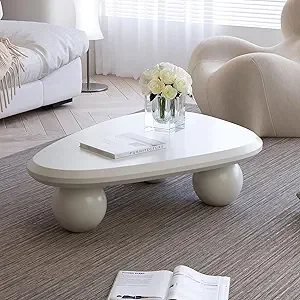
Caring for Your Solid Wood Coffee Table
Proper maintenance ensures your solid wood coffee table remains beautiful for generations. Following these care guidelines will help preserve the natural beauty of your investment piece.
Daily Care Essentials
Protect your table from common hazards:
• Always use coasters under drinks to prevent water rings
• Use placemats or trivets under hot items
• Dust regularly with a soft, slightly damp cloth
• Wipe in the direction of the wood grain
• Clean up spills immediately, especially alcohol or acidic liquids
• Maintain consistent indoor humidity (30-50%) to prevent wood movement
Cleaning Best Practices
Keep your table clean without damaging the finish:
• Use mild soap and water for general cleaning, immediately drying afterward
• Avoid silicone-based sprays that build up over time
• Never use harsh chemicals, ammonia, or abrasive cleaners
• Choose cleaners specifically formulated for your table’s finish type
• Test any new product in an inconspicuous area first
Preventive Maintenance
Protect your investment with these preventive measures:
• Apply quality furniture wax or polish appropriate for your finish type 2-4 times yearly
• Position table away from direct sunlight to prevent uneven fading
• Use felt pads under any items kept permanently on the table
• Consider seasonal humidity changes—wood expands in summer and contracts in winter
• Periodically check for loose joints or developing issues
Dealing with Damage
Address minor problems before they worsen:
• For small scratches, try a matching wood touch-up marker or stick
• Treat water rings with non-gel toothpaste or specialized ring remover
• Minor dents can sometimes be raised by placing a damp cloth over the area and applying a warm iron
• Consider professional refinishing for significant damage or when the finish wears through
For specific care instructions tailored to different finishes and wood types, our guide to black mid-century modern coffee table styles includes maintenance tips for various wood finishes.
Is Solid Wood Always the Best Choice? Honest Considerations
While solid wood offers many advantages, it’s important to consider situations where alternatives might be appropriate. This balanced perspective helps ensure you make the right choice for your specific circumstances.
When Solid Wood May Present Challenges:
Mobility Considerations:
Solid wood furniture is significantly heavier than alternatives. If you relocate frequently or need to regularly rearrange your space, the substantial weight of hardwood tables may become impractical. Softwoods like pine offer a lighter alternative while still providing natural wood benefits.
Climate Extremes:
Solid wood naturally responds to humidity changes by expanding and contracting. In areas with dramatic seasonal humidity fluctuations or very dry conditions, this movement can sometimes lead to issues like cracking or warping without proper care. Climate-controlled environments help mitigate these concerns.
Budget Constraints:
Quality solid wood represents a significant investment. If budget is a primary concern, consider:
• Softwoods like pine for more affordable solid wood options
• High-quality veneers over engineered wood for a stable alternative
• Smaller solid wood pieces rather than larger tables
Special Situations:
Small Spaces:
In compact living areas, the visual weight of some solid wood pieces might overwhelm the space. Consider:
• Lighter-colored woods like maple or ash
• Tables with slender proportions
• Pieces with open bases or glass elements
Outdoor Use:
Only specific woods like teak, white oak, or ipe are naturally suitable for outdoor exposure. For outdoor coffee tables, these specific species or proper outdoor materials are essential.
Sustainability Considerations:
Look for FSC-certified wood sources that ensure responsible harvesting practices. Reclaimed wood and fast-growing domestic species generally have smaller environmental footprints than exotic hardwoods.
For versatile alternatives that maintain quality while addressing some of these considerations, consider exploring our mid-century modern nesting coffee tables that combine space efficiency with quality materials.
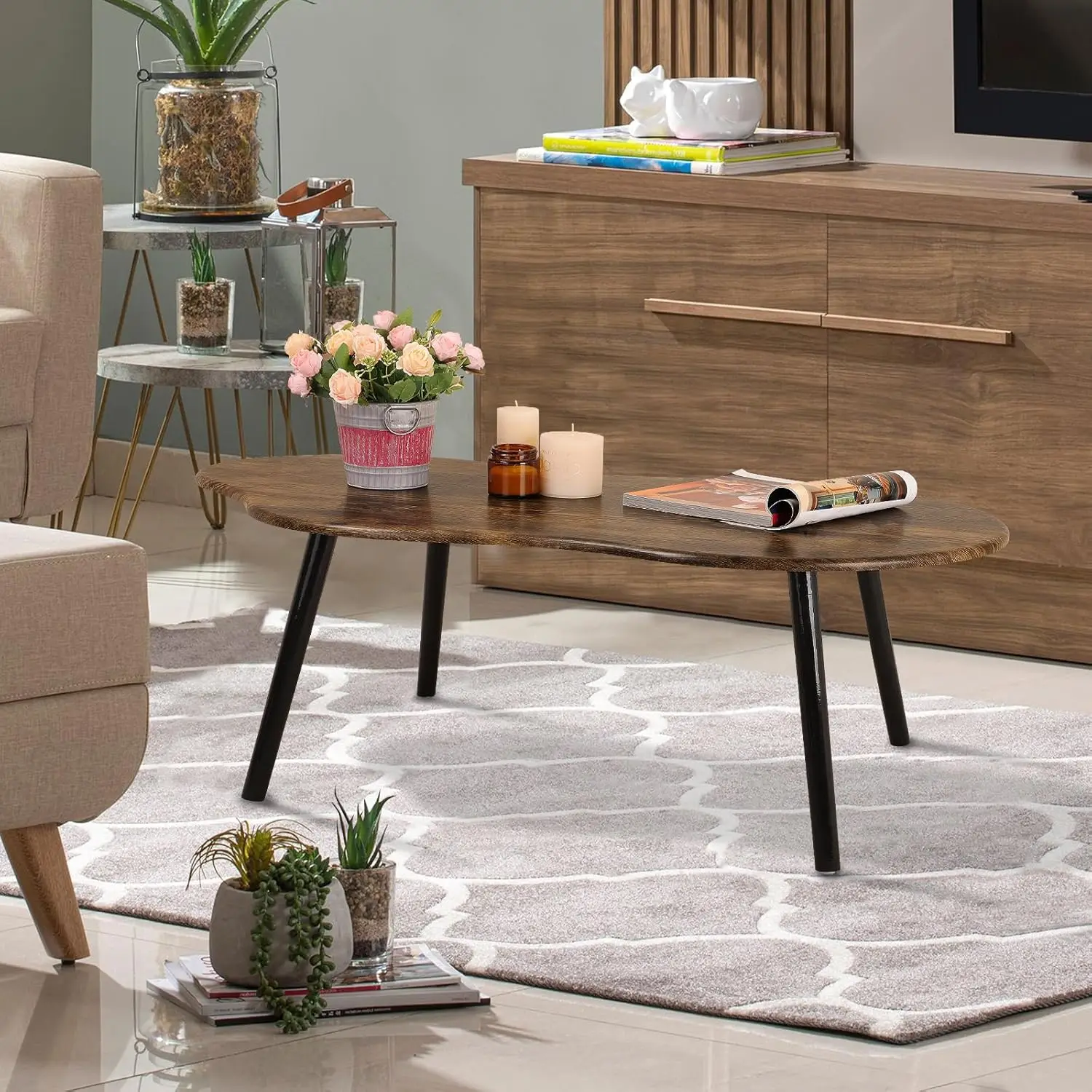
Frequently Asked Questions About Solid Wood Coffee Tables
How can I verify if a coffee table is truly solid wood?
Look at the underside and edges of the piece. Solid wood shows consistent grain patterns throughout. Check weight—solid wood is substantially heavier than alternatives. Examine any exposed end grain at joints. A slightly rough texture when running your hand across the grain (as opposed to along it) also indicates real wood.
What is the most durable wood for a family with young children?
Hard maple offers the best combination of hardness and durability for active families. White oak is a close second with excellent resistance to dents and moisture. Both can withstand decades of family use while maintaining their appearance.
How much should I expect to pay for a quality solid wood coffee table?
Quality solid wood coffee tables typically start around $700-$800 for simpler designs in domestic woods like oak. Mid-range options in walnut or cherry generally run $1,000-$1,800. Premium designer pieces or tables in exotic woods can easily exceed $2,000. The investment reflects materials, craftsmanship, and longevity.
Will my solid wood coffee table match my existing furniture?
Complete matching isn’t always necessary or even desirable. Focus on complementary tones and styles rather than exact matches. Consider undertones (warm vs. cool) and overall color palette. Wood tables actually work best when they coordinate rather than match exactly, creating a collected-over-time appearance that feels more natural.
How do I remove water rings from my wood table?
For white rings (moisture in the finish), try gently rubbing with non-gel toothpaste or a mixture of equal parts vinegar and olive oil. For dark rings (moisture in the wood itself), professional refinishing may be required. Prevention with coasters is much easier than removal.
How often should I polish or oil my coffee table?
For tables with standard lacquer or varnish finishes, apply quality furniture polish 3-4 times per year. Oil-finished tables typically need refreshing every 3-6 months with an appropriate wood oil. Tables with wax finishes benefit from re-waxing once or twice annually.
Can solid wood coffee tables be used outdoors?
Only specific species with natural decay resistance are suitable for outdoor use. Teak, white oak, and ipe are traditional outdoor woods. Even these should ideally be under cover and receive appropriate outdoor-specific finishes and maintenance. Standard indoor solid wood tables will quickly deteriorate outdoors.
Is reclaimed wood as strong as new wood?
Reclaimed wood from old-growth forests is often stronger and more stable than new wood because it came from older, more slowly grown trees with denser growth rings. However, quality varies greatly depending on the source and previous use, so examination of the specific piece is important.
For additional practical solutions that address common living space needs, explore our mid-century modern lift-top coffee tables that combine beautiful wood with enhanced functionality.


